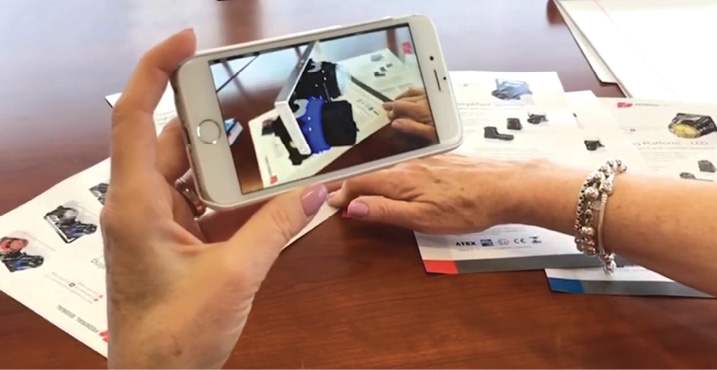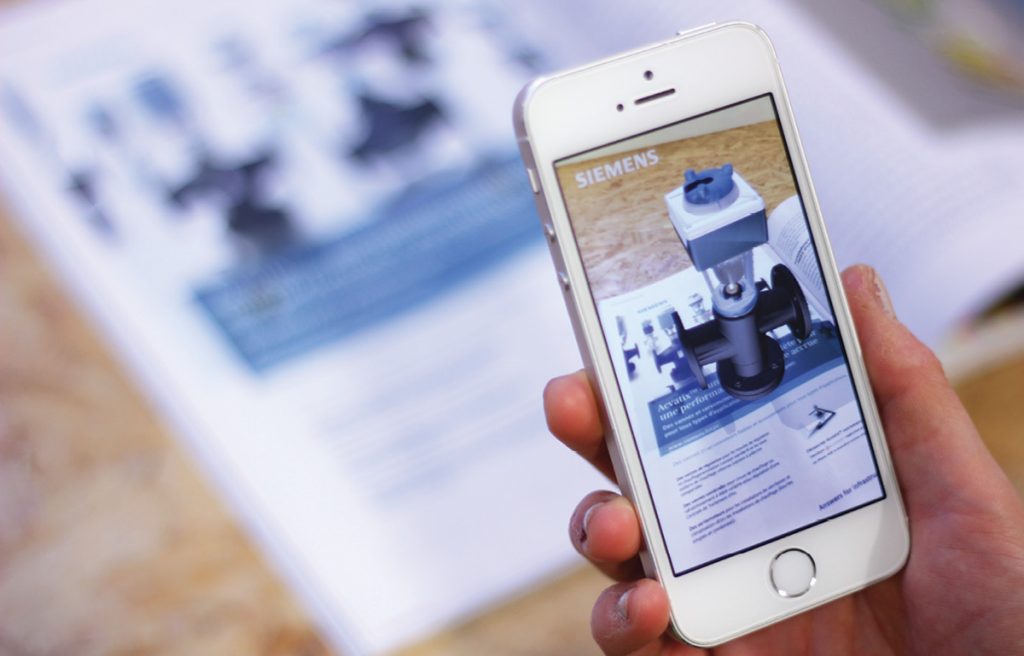
With Augment’s mobile app, Federal Signal customers can point their mobile device to the AR code-embedded brochure to inspect a product as if it were sitting before them in true-life scale. Image courtesy of Federal Signal.
May 1, 2017
On the road, when negotiating the distances between their vehicles and others, drivers get a helpful reminder from the safety warning “objects in the mirror are closer than they appear.” In speedy e-commerce, where many products are marketed and sold on the basis of the way they look on a webpage, some consumers might benefit from the warning “objects in the digital catalog are larger than they appear.”
Nirmal Chudgar, head of products for Federal Signal, discovered this when he decided to take a look at an industrial speaker, one of the biggest revenue generators in his employer’s portfolio. “I’d always seen the picture of it. It seemed like a 6-in. speaker to me,” he recalls. “But when the box was finally delivered to my office, it was much bigger than I’d imagined it.”
 With Augment’s mobile app, Federal Signal customers can point their mobile device to the AR code-embedded brochure to inspect a product as if it were sitting before them in true-life scale. Image courtesy of Federal Signal.
With Augment’s mobile app, Federal Signal customers can point their mobile device to the AR code-embedded brochure to inspect a product as if it were sitting before them in true-life scale. Image courtesy of Federal Signal.Chudgar was looking at the image of the speaker in isolation on a webpage. If he had seen a photo of it sitting next to a standard tool chest or a lightbulb, he could have better judged its dimensions.
Jean-Francois Chianetta has had a similar experience while shopping online. A published review proclaims it was the biggest of its kind. But the digital photo didn’t convey its scale. That’s when Chianetta got the idea to develop an application to “visualize 3D models in the real world,” as he put it. It eventually led to the launch of his new company, Augment, in October 2011.
Today, Federal Signal is a client of Augment. Chudgar’s sales people use Augment’s technology to let clients see and experience products before the transaction. For the client, it’s a chance to visualize the product in the real environment. They can, for example, understand how Federal Signal’s industrial alarm systems—a combination of flashing lights, beacons and sirens—would fit into their factories and plants. For the sales reps, it’s a way to impress the client with the “wow factor”—something a photo, catalog or mockup won’t deliver.
Augmented Reality Triggered by Printed Catalogs
Having studied mechanical engineering in Belgium and Canada, Chianetta began working as a software engineer for Coventor, which caters to semiconductor developers. The job allowed him to explore the intersection of mechanical design, 3D modeling, microelectromechanical systems (MEMS) and user interfaces. Those insights and knowledge found their way into the technology of Augment.
Augment targets two segments in particular: manufacturing and retail. It operates with 40 employees from 14 countries, and has 200 clients in 36 countries. It offers a software developer kit (SDK), a desktop program and a mobile app. The desktop program allows you to apply materials to your 3D CAD model, apply animation triggers, refine it and upload it to the cloud. The Augment mobile app can interpret a marker—a paper printed with a computer code—as a 3D model. Therefore, you can use the app to point at a marker to virtually import a 3D model into the live camera view.
With this technology, you can “make your brochures and catalogs interactive ... [and] let customers unlock your entire inventory of products to try at home through a scan of your 2D marketing collateral,” Augment explains on its website.
A Memorable “Wow Factor”
Some view augmented reality (AR) apps as an offshoot of the videogame market; good enough for entertainment but not for serious business. Others stay away from what they view as early phase technology with room for improvement. But Chudgar thinks being an early adopter gives Federal Signal an advantage.
 Augment offers enterprise AR solutions for retailers and manufacturers. Shown here is a product by the manufacturing giant Siemens virtually imported into a mobile device’s live camera feed via Augment’s app. Image courtesy of Augment.
Augment offers enterprise AR solutions for retailers and manufacturers. Shown here is a product by the manufacturing giant Siemens virtually imported into a mobile device’s live camera feed via Augment’s app. Image courtesy of Augment.“Popular technologies don’t always get adopted early in the industrial market,” Chudgar explains. “So this gives us the ‘wow factor.’”
When Federal Signal employees visit clients, they still bring catalogs and brochures, but when viewed with the Augment mobile app, the predesignated markers in those brochures come alive. They become 3D models that can be rotated, reoriented, inspected from different angles and distances—and even positioned roughly in the spot where they might be installed after purchase.
“Our products in the latest Global Series, for instance, are industrial size beacons and speakers. They’re meant for hazardous environments, like oil refineries. A lot of them get installed in places with risk of explosions,” Chudgar says. With a simple photo, “[the client will] remember that the product is bright, or loud, but it doesn’t make the same impression,” he says. “[Augmented reality] gives the client another reason to remember the product.”
What Happened After You Left
When it comes to recordkeeping and analytics, the cloud offers a much better paper trail than traditional paperwork. The mobile app collects viewing data in a way that’s unobtrusive. After a client visit, the sales rep doesn’t have to pester a prospective client with another email or a phone call to inquire if he or she has had a chance to look at the brochure and discuss it with the purchasing manager. The mobile app offers analytics that reveal what happens to the AR code-embedded brochure after the sales call.
“We can actually track who is viewing [the 3D model], and how often, so we can tell if the demo is popular or not,” Chudgar says. The analytics function is part of a supplementary package that Augment offers.
Often, Federal Signal wants to give its top-tier clients a sneak peek or preview of its upcoming products still under development, and the Augment mobile app is the perfect delivery vehicle. For a start, the product only exists as a 3D model because it hasn’t been built. Further, previewing it inside a mobile app works well as an intellectual property protection measure. Unlike a detailed CAD model, the low-resolution, lightweight model inside an AR app cannot easily be exported and used to reverse-engineer a product.
Chudgar says that, with the Augment app, he feels comfortable showing the products still in R&D even at crowded tradeshows. “I can do it without any of our competitors walking by and discovering what the new product looks like,” he says. A mockup or a prototype displayed on a table, on the other hand, would be accessible to everyone at a tradeshow, including Federal Signal’s competitors.
The Handoff
Federal Signal uses SOLIDWORKS, a mechanical CAD software package, to design its products. AR programs typically do not display 3D models in native CAD formats due to compatibility issues and large file sizes. CAD models are intended as faithful representations of the products to be manufactured, down to the nuts, bolts, rounded edges and holes. The level of geometric details is overkill for AR visualization, so a conversion process is needed to prepare the CAD models for AR applications. Such conversions are partially automated in some AR content publishing programs, but they are seldom fully automated.
Chudgar says his company contracted Augment for some conversion and rendering services. He wants AR vendors to offer much simpler conversion and publishing tools. “Businesses usually don’t have a budget for AR,” he says. “It’s an add-on, so not every company can spend a few more thousands for file format conversion or rendering. The more DIY, the better it is.”
The AR Race
The transition from CAD to AR/VR content will gradually improve as more CAD software developers invest in the development or acquisition of AR/VR technologies. SolidWorks, the company behind the SOLIDWORKS CAD software, has already added AR functions to its free file viewer eDrawings, available for mobile devices. Dassault Systemes, the parent company of SolidWorks, acquired RTT (Realtime Technology) in 2013. The transaction made RTT’s AR product line part of the Dassault Systemes portfolio. RTT has since been rebranded as 3DEXCITE. PTC, another CAD software maker, acquired the AR firm Vuforia in 2015 as part of its strategy to enable the creation of digital twins.
Chudgar thinks AR is not just an effective tool for sales and marketing, but also for engineering and product development. “What’s important is getting the full perspective,” he says. “If the engineers look at a virtual car mockup in isolation, they can’t tell how big or small it is, but with a house behind it, it gives a much better perspective.”
More Info
Subscribe to our FREE magazine, FREE email newsletters or both!
About the Author
Kenneth Wong is Digital Engineering’s resident blogger and senior editor. Email him at [email protected] or share your thoughts on this article at digitaleng.news/facebook.
Follow DERelated Topics






